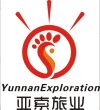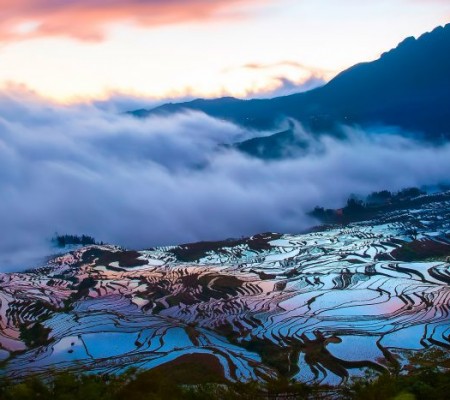
The Source of Honghe (Red) River in Weishan County, Dali
Natural Geography
-
Location and Scope: The source of the Red River is located in Milumo Village, Yongjian Town, Weishan County. In Weishan, the river formed by the source is locally known as the West River and was historically called Yanggu River. The designated key protection area for the Red River Source includes both banks of the Yanggu River (50 to 100 meters wide), reservoirs such as Fukang Reservoir and their watersheds, as well as areas above an altitude of 2,400 meters in the Red River Source Village.
-
River Course and Length: Starting from its source, the Red River flows through Dali, Chuxiong, Yuxi, and Honghe in Yunnan Province. It exits China at He Kou County in Honghe Prefecture and flows into Vietnam, eventually emptying into the Pacific Ocean’s Gulf of Tonkin. The river is over 1,200 kilometers long, with 690 kilometers within Yunnan Province and 500 kilometers in Vietnam.
-
Topography and Landforms: Weishan County is situated between the Ailao Mountains and Wuliang Mountains. The Red River Source Geological Park covers an area of approximately 239.51 square kilometers and is a large geological park themed around river and basin landforms.
History and Culture
-
Name Meaning: In the Yi language, the Red River Source is called “Egu Abao,” which means “the father of a winding river.” Unlike most rivers in the world that are referred to as “mother rivers,” the Red River has been called the “father river” from the beginning.
-
Historical Background: The Red River Source area gave birth to the Nanzhao Kingdom and Nanzhao civilization. Ancient Weishan was the capital of the Nanzhao Kingdom and the seat of the Menghua Prefecture. Due to the relationship between Nanzhao and the Tang Dynasty, the river was named “Lishe River” as a gesture of respect.
-
Cultural Relics: Weishan Ancient City, the birthplace of the Nanzhao Kingdom, was designated as a National Historical and Cultural City in 1994. It preserves numerous historical relics and traditional buildings, complementing the rich cultural landscape of the Red River Source.
Ecological Environment
-
Ecosystem: The Red River Source area features a complex and diverse ecosystem, with forests, shrubs, and meadows providing habitats for many plants and animals. It is also a key migration route for numerous migratory birds.
-
Vegetation Types: The region has a variety of vegetation types, including tropical rainforests, subtropical evergreen broadleaf forests, and temperate evergreen broadleaf forests, some of which are rare species.
-
Conservation Measures: Weishan County has enacted the “Regulations on the Protection of the Red River Source in Weishan Yi and Hui Autonomous County,” clearly defining the protection scope, measures, and management responsibilities to strengthen the conservation of the Red River Source.
Tourism Resources
-
Natural Scenery: The Red River Source area offers unique natural landscapes, including rivers, canyons, waterfalls, and forests. The river within Weishan County is known for its winding course, earning the nickname “Nine Bends and Eighteen Turns.”
-
Cultural Scenery: In addition to natural landscapes, the Red River Source area is rich in cultural attractions, such as Weishan Ancient City, Niaodao Pass, and Weibao Mountain. These sites are historically significant and artistically valuable.
-
Tourist Activities: Visitors can enjoy hiking, adventure, photography, and other activities in the Red River Source area, experiencing the beauty of nature and the depth of historical culture.
Conservation Measures
-
Legal Protection: Weishan County has enacted the “Regulations on the Protection of the Red River Source in Weishan Yi and Hui Autonomous County,” legally defining the protection scope, measures, and management responsibilities.
-
Designated Protection Zones: Key protection zones have been designated to strictly conserve water resources, forests, and the ecological environment in the Red River Source area.
-
Ecological Restoration: Through reforestation and forest conservation efforts, the ecological environment of the Red River Source area is being restored, with improved forest coverage and enhanced ecological conditions.


http://www.sohu.com/a/160584431_653779

 7 Days GolfingTour
7 Days GolfingTour
 8 Days Group Tour
8 Days Group Tour
 8 Days Yunnan Tour
8 Days Yunnan Tour
 7 Days Shangri La Hiking
7 Days Shangri La Hiking
 11 Days Yunnan Tour
11 Days Yunnan Tour
 6 Days Yuanyang Terraces
6 Days Yuanyang Terraces
 11 Days Yunnan Tour
11 Days Yunnan Tour
 8 Days South Yunnan
8 Days South Yunnan
 7 Days Tea Tour
7 Days Tea Tour
 8 Days Muslim Tour
8 Days Muslim Tour
 12 Days Self-Driving
12 Days Self-Driving
 4 Days Haba Climbing
4 Days Haba Climbing
 Tiger Leaping Gorge
Tiger Leaping Gorge
 Stone Forest
Stone Forest
 Yunnan-Tibet
Yunnan-Tibet
 Hani Rice Terraces
Hani Rice Terraces
 Kunming
Kunming
 Lijiang
Lijiang
 Shangri-la
Shangri-la
 Dali
Dali
 XishuangBanna
XishuangBanna
 Honghe
Honghe
 Kunming
Kunming
 Lijiang
Lijiang
 Shangri-la
Shangri-la
 Yuanyang Rice Terraces
Yuanyang Rice Terraces
 Nujiang
Nujiang
 XishuangBanna
XishuangBanna
 Spring City Golf
Spring City Golf
 Snow Mountain Golf
Snow Mountain Golf
 Stone Mountain Golf
Stone Mountain Golf




